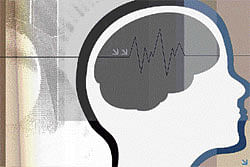
A “three-pound jelly sitting in you” – the human brain with 100 billion cells – does incredible multi-tasking, from creating music, poetry, brewing evil to contemplating God and nature of religion.
And when world-renowned Indian-born neurologist Vilayanur S Ramachandran, hailed by famed British evolutionary biologist Richard Dawkins, as the ‘Marco Polo of neuroscience’, begins exploring the stuff of human consciousness, he can get delightfully passionate and messianic.
“Today, I am in a todi (raga) mood,” Ramachandran exults. He was speaking at the launch of his latest book, ‘The Tell-Tale Brain’. It was certainly a delineation of a profound melody as he stopped short of unmasking the ‘Self’ or atman. It seems everything else modern neuroscience knows, and yet some of the deepest mysteries of the human brain remain far from unlocked.

As Dr Ramachandran, Director of the Centre for Brain and Cognition and Professor with the Psychology and Neurosciences Department at the University of California, USA, brilliantly held forth on the mysteries of the human brain, nothing could have been more apt than he being in a ‘todi’ mood, what with flashes of insights and a dash of humour.
Though the brain-geography he covered in 90 minutes was far too vast, some incisive case studies he explained from his long years of research, revealed refreshing and liberating perspectives in our understanding of mental disorders and personality development.
Ramachandran began by saying that there are many approaches to the study of the human brain. One much-hyped approach is ‘brain imaging’, to find out what part of the brain is active when we perform a particular task.
Cognitive neuroscience
However, there is another method as well, the structural-functional correlative approach in cognitive neuroscience. This research paradigm has, in the last two centuries, been alternating between two basic questions, whether the brain functions in a holistic manner or whether different parts of the brain specialise in different functions, the modular studies, he noted. For the neuroscientists, the crisscross of the two queries is always exciting.
Just one case study of Dr Ramachandran gives an idea of the new windows of comprehension opening up in brain studies. A person who suffered a brain injury comes out of his coma in about two weeks. He is clearly intelligent and normal in every other aspect except that at the sight of his mother, he believes she is “an impostor”, and not his real mom.
Such a bizarre ‘neuro-psychiatric syndrome’, in the 19th century psychoanalysis developed by the great Sigmund Freud may be seen as the playing out of what the latter called the ‘Oedipus Complex’- drawing on the Greek myth of Oedipus who unknowingly slayed his father to marry his mother and later blinded himself when he knew that she was his mother-.
But Dr Ramachandran argued that such incomprehensive disorders can now be more simply and precisely explained by ‘cognitive neuroscience’.
“We did a simple experiment and it just took us a few hours to test this out,” he said. Because of a head injury, the patient’s cortex was damaged. His vision and emotions were normal but the “correlation between emotion and vision was severed after a head injury in a car accident,” the scientist detailed. According to the neuroscientist, a seemingly bizarre mental disorder can now be experimentally shown as a highly selective loss in one function of the brain and one could jettison the Freudian ‘Oedipus Complex’ theory.
The same patient was able to identify his mother’s voice when she called him over phone, but when she was in his presence, the patient refused to believe she was his mother.
This showed that the auditory centre of the brain, was very much in place, but the visual centre of the brain was severed. Therefore, when the patient saw his mother in person, the emotions “were not able to recall” that she was his mother, asserted Dr Ramachandran.
Synesthesia
In another case that the scientist calls ‘synesthesia’, every time a person sees a number, he/she also sees a colour. “Five is green, eight is red,” and so on. The latter is very significant as synesthesia is found “eight times more commonly in artistes, poets and novelists than others,” largely explaining their creative abilities, the scientist stressed.
Dr Ramachandran’s studies now show all these to be concrete sensory phenomena, whose neural basis in the brain has been pinned down. It gives an “experimental foothold to understand the more complex, elusive aspects of the mind,” he said.
Will this mean we will lose the great universal heritage of human myths and legends as the key to human behaviour? Well, that may be another challenging study for this neuroscientist, who according to Newsweek is among the 100 most important people to watch in the 21st century.
Deccan Herald is on WhatsApp Channels| Join now for Breaking News & Editor's Picks